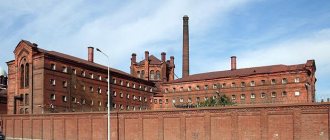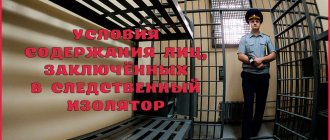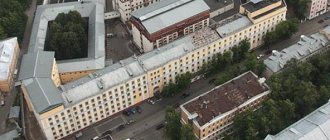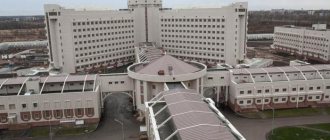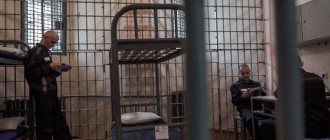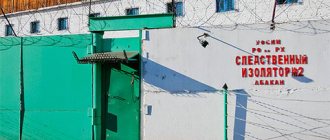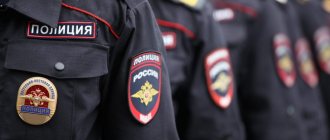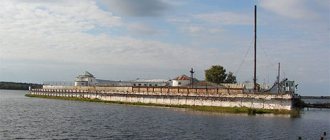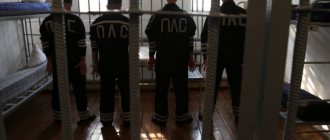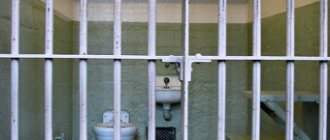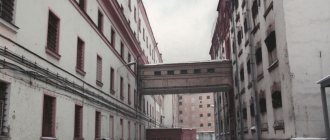St. Petersburg “Crosses” is one of the most famous and largest pre-trial detention centers in Russia. It bears the official name of FKU “SIZO-1” of the Federal Penitentiary Service of Russia for the city of St. Petersburg and the Leningrad region.
Built in 1892, the prison by the beginning of the 21st century had a number of problems related to overcrowding, lack of bedding and general dilapidation of the building. It was impossible to reconstruct the “Crosses” for two reasons: because of the law prohibiting the reconstruction of architectural monuments, which is the building of this institution, and because of the inability to transport prisoners anywhere during the renovation.
In 2006, a decision was made to build a new pre-trial detention center, and on December 22, 2022, all prisoners were taken to the new “Crosses” on the outskirts of Kolpino near St. Petersburg, where the institution remains to this day. This article is dedicated to the old legendary “Crosses”, partly thanks to which St. Petersburg is endowed with gangster fame. Let's consider why the prison is called that, what is the history of the founding of the pre-trial detention center, as well as which of the famous prisoners were imprisoned in this prison and other nuances.
What is it: characteristics of the old MLS in St. Petersburg
“Kresty” is a pre-trial detention center where suspects and accused of crimes are kept. They are not yet convicted, since the court has not yet pronounced a verdict against these persons. The only preventive measure in the form of detention was applied to them. Until the sentence passed by the judge comes into force, the person will remain in isolation and will not be transferred to another institution.
A pre-trial detention center is not a correctional institution; it is not intended to hold prisoners on a permanent basis. Serving a sentence in a pre-trial detention center is only possible if the sentence does not exceed six months.
Where is it located, the address of the pre-trial detention center: 195009, St. Petersburg, Arsenalnaya embankment, 7.
Telephone number of the duty station of this prison: 8 (812) 542-90-14.
The head of the institution is Colonel of the Internal Service Vadim Aleksandrovich Lvov. Reception of citizens on all issues is carried out every second and third Wednesday of the month from 11.00 to 12.00.
You must make an appointment in advance by calling 8 (812) 542-47-35. You can also ask questions to the management of the institution through the online reception https://www.kresty.ru/content/feedback/.
There is a Crosses page on the GUFSIN website – https://78.fsin.su/structure/sizo1.php. In addition, there is an official website of the institution https://www.kresty.ru/, groups on social networks https://vk.com/club2032202, https://vk.com/club1594317, https://vk.com/ kresty_spb.
Those held in a pre-trial detention center have the right to short-term visits (remember that long-term visits in a pre-trial detention center do not exist in principle), applications for which are filled out in the name of the head of the institution. The room's opening hours are from Monday to Saturday from 8.00-16.30 (lunch from 12.00-13.00).
Visiting of museum
Museum of Crosses
Citizens can visit the museum on their own; the limit is for children 14+.
Opening hours: Mon-Fri 9.00 – 17.00, Saturday and Sunday days off.
Ticket price: 50 rubles for citizens of the Russian Federation, otherwise 250 rubles.
Important information! Having a passport when visiting the museum is mandatory!
Photos of St. Petersburg Crosses outside and inside
In the following photo you can see what this MLS looks like:
Institution infrastructure
Why is the prison called “Crosses”? The pre-trial detention center consists of two cruciform five-story buildings , the second building has the same structure as the first. This is where the name of the prison “Kresty” came from. This form was not chosen by chance: at the intersection of two corridors there is a platform from which you can see everything that happens at all four ends and on all floors, with the exception of the fifth, basement. This form is convenient not only because it is visible, but also because it reduces the possibility of prisoners communicating with each other.
The stairwells are covered with metal mesh to protect defendants from accidental injury or intentional suicide. Between the buildings of the detention center there is an administrative building, on the top floor of which is the Church of St. Alexander Nevsky.
The territory also contains four hospital buildings, a laundry, an icehouse , a dormitory for guards, a boiler room with an electric generator, an infectious disease building, a bathhouse and a kitchen with a bakery.
The service personnel at Kresty are the prisoners themselves, who go on duty according to a specific schedule.
Excursion program around the complex
- a walk through the territory of the pre-trial detention center, where you can see a football field and a playground with exercise equipment;
- visiting administrative buildings;
- regime buildings in the shape of a cross;
- demonstration of the prisoners' cell;
- viewing the museum exhibition;
- visit to the Church of Alexander Nevsky.
Guides will introduce visitors to the entire complex of the structure. Supervision and corrections officers will talk about the peculiarities of serving in a pre-trial detention center.
The tour runs daily from 11:00 am. Ticket price is 500 rubles.
Walk “Around the Crosses”
walking tour “Around the Crosses” is of interest . It includes:
- external inspection of the Krestov prison buildings;
- building with the image of a magic square;
- monument to V.I. Lenin at the Finland Station;
- the mystical Liteiny Bridge;
- inspection from the embankment of the KGB - FSB building "Big House".
Held on Sundays, the tour starts at 13.00. Meeting on Lenin Square near the station. Price – from 600 rub. .
Conditions of detention in the St. Petersburg pre-trial detention center
The isolation ward has 960 cells, each measuring 8 sq.m. Initially, during construction, they were planned to be single, but at the moment they contain 2-3 people. In the overcrowded nineties, the number of people in the cell reached 13. The cell contains two-tiered metal narrow bunks, a table, two chairs, and a shelf with personal belongings for each prisoner. Clothing and utensils are allowed “from the outside,” as well as books, personal items, and hygiene items.
The cell has a tap with running water and a toilet . Prisoners are provided with a bathhouse once a week, the duration of water procedures is 15 minutes. Maintaining cleanliness in the cell is the responsibility of the prisoners.
We invite you to watch a video about the conditions of detention in the pre-trial detention center:
Schedule
A prisoner's day begins at 6 a.m. and ends at 10 p.m. The ascent is signaled by the inclusion of bright lights and the radio. After this, it is forbidden to be on the bunk until lights out. Within an hour, prisoners make their beds, wash themselves, and tidy up their cells. Afterwards - breakfast and morning check.
At 9.30 the prisoners go on a walk, which takes place in a small room surrounded by concrete walls. There are bars and barbed wire above this room. Prisoners go out for walks in the same group as they are in their cells . During this time, their cells are subject to sanitization and inspection for storage of prohibited items.
At 12.00 – lunch, at 17.00 – dinner. During the day, prisoners can play board games, read books, write letters, which at the end of the day can be handed over to the prison guards to pass censorship, and engage in their hobbies. After lights out, the radio turns off, but the dim lighting remains.
Meals for prisoners
Prisoners in pre-trial detention centers are entitled to three hot meals a day . Porridge is served for breakfast, soup for lunch, and the second course is porridge again, but with the addition of meat. For dinner there is also porridge, but with fish or vegetables. Prisoners are allowed tea as a drink. For medical reasons, some prisoners are prescribed dietary nutrition, then chicken or beef, eggs and dairy products are added to their diet.
The food in the pre-trial detention center is very meager and monotonous, so food donations are welcome.
Work and study
Since the pre-trial detention center is a place of temporary detention for prisoners , the opportunity to work or study is not provided here. Although initially “Kresty” was a prison where all prisoners worked, in the 50s of the twentieth century it was completely self-sufficient due to the cardboard factory organized on the territory, and during the Great Patriotic War a number of samples of military equipment were developed here.
In 1964, there was a change of regime, and Kresty became an isolation ward, not a prison camp, so prisoners could no longer work here.
Religious issues
The attitude towards religion in “Crosses” is tolerant . Initially, during the construction of the prison, the Church of St. Alexander Nevsky was erected here, which became a club in Soviet times. But since the late 90s, work has been carried out to restore the church; in 2004, the altar and iconostasis were returned. Entrance here is always free for prisoners.
On holidays, services are held in the church; the pre-trial detention center is regularly visited by a priest who confesses and gives communion to the “parishioners.” The Bible and Gospel are freely available in the library, which are in great demand in the detention center.
Representatives of other faiths in the pre-trial detention center are also treated with understanding.
Entertainment and relaxation
In their free time, prisoners are allowed to play board games, which are sent in parcels and packages. The pre-trial detention center has a fairly large library, which is actively used. Employees note that books on religious topics and Russian classics are the most popular among prisoners.
Having free time also inspires prisoners to be creative. The most popular genres here are drawing (including icons), modeling from bread crumbs and crafts from paper and cardboard.
There is a club in “Kresty” where entertainment events are held for various holidays. The prisoners themselves act as decorators, artists and screenwriters here. In the same club, prisoners are sometimes shown various films.
Dates and visits
According to Article 89 of the Penal Code of the Russian Federation, prisoners can be granted no more than two visits per month, lasting up to three hours each. Visits are carried out under the control of guards and if there is an attempt to transfer prohibited items or information to the prisoner that may hinder the investigation or contribute to the commission of another crime, they are interrupted early.
To obtain permission to visit, you must write an application addressed to the head of the pre-trial detention center. In some cases, refusal is possible, most often this can happen due to the illness of the arrested person or in case of violation of the regime (or in an exceptional case when the investigation considers that your visit may interfere with the investigation).
Transfer of products and things
According to Art. 90 of the Penal Code of the Russian Federation, prisoners in pre-trial detention centers are allowed to receive any number of parcels, the weight of which must comply with the rules of mail, as well as transmission, with a total weight of no more than 30 kg per month. For prisoners suffering from serious illnesses (if there is a medical report from the institution’s doctors), there is no weight limit for parcels.
Items, substances and food products that may be dangerous to the life and health of people or used as weapons of crime are prohibited from being handed over to prisoners.
All types of alcoholic beverages , foods that require heat treatment, home-made canned food and perishable foods (dairy products, semi-finished products) are strictly prohibited for transfer.
All products must be factory produced with a stated expiration date.
It should also be remembered that all parcels and transfers undergo thorough inspection , so product packaging must be transparent, otherwise it will be opened. For example, some of the cigarettes will be broken, in case you hid something there.
Opening hours of the delivery bureau: from 8.00 to 17.00 (lunch from 12.00 to 13.00) daily, sanitary day is the last Sunday of each month.
If it is impossible to bring the package, then you can place an order at a local store , and then everything will be delivered directly to the cell, bypassing the inspection procedure, which is especially important for tobacco products. The order desk is open from Tuesday to Saturday from 8-30 to 16-30, lunch from 12-00 to 13-00.
The most relevant products for transfer are those that are a kind of currency in the pre-trial detention center: instant noodles, sugar, salt, and especially tea and cigarettes.
Among the things that are in great demand for donation at “Kresty” are: bed linen, towels, dishes and spoons (made of plastic or wood), underwear, tights, socks, personal hygiene products (soap, razors, toilet paper).
Punishment cell
For violation of the regime or disobedience to the staff of the pre-trial detention center, the prisoner is sent to the Penal Temporary Detention Isolator (SHIZO). In Kresti this is a room not exceeding 4 square meters, located in the basement, with a very small window near the ceiling. The prisoner is there alone, the bunks nailed to the wall are folded up for the daytime, time here has to be spent on your feet or on the damp and cold floor.
In addition, the daily ration in the punishment cell has been reduced. According to Article 118 of the Penal Code of the Russian Federation, the period of stay in a punishment cell should not exceed 15 days.
Museum
Museum of Crosses
1993 was the starting point for the creation of the Crosses Museum. Excursions were conducted only for law students and law enforcement officials. Since 1999, the museum has been accessible to visitors. Museum workers conducted excursions around the administrative and security buildings with a visit to the temple.
Museum exhibitions occupied two small rooms. The exhibits testify to changes, events in the “Crosses”, lifestyle, and the inner world of the inhabitants of the institution. In 2007, excursions were temporarily stopped due to difficulties encountered in the work of the pre-trial detention center staff.
On November 18, 2022, the Kresty museum complex reopened to all visitors. The preservation of an architectural monument and museum exhibition is important for the history and education of young people. So that they remember, know and don’t repeat it...
What is the exposition of the prison museum?
- Documentary evidence related to the historical facts of the life of the country, this institution, and the tragedies of innocently convicted prisoners. Documents on the transformation of the prison for the entire period of its existence.
- The model of the prison demonstrates the architectural design and helps to understand the location of buildings.
- Shackles, types of cell keys.
- Exhibitions of photographs of famous prisoners and political prisoners.
- Information about the activities of the administration in different years.
- Items confiscated from the arrested: chess pieces made from bread crumbs, wooden products, drawings, crafts made from paper and cardboard. Sharpeners, homemade knives, hiding places, binoculars, rolled up notes, and musical instruments are of great interest to tourists.
- Images of tattoos on posters, tattoo machines. Each tattoo has a meaning, symbolizes belonging to a prison caste, and bears responsibility in the criminal world. For example, a tattoo of a ring on a finger with a cross and a crown indicates that the person was a prisoner of the “Crosses.”
- A special group highlights items confiscated from clergy in the 1930s: crosses, icons, etc.
Features of the prison regime
"Kresty" is one of the most famous places of detention in Russia . One of the distinctive features of this place of deprivation of liberty is that since the 90s of the twentieth century, “Crosses” was the most overcrowded prison on the territory of the Russian Federation. At times the number of prisoners reached 12 thousand people.
There were 13 prisoners in 3 bunk cells, and they were forced to take turns sleeping. The air temperature in the cells reached 40 degrees and rarely fell below 30, and the stench, sweat, and smoke were added to this. This contributed to the development of unsanitary conditions and disease, and made prison conditions particularly difficult.
History from the foundation
Construction of the “Crosses” began in 1884 by order of Nicholas II under the leadership of the architect A. Tomishko. The unusual shape of the insulator was his idea. According to the master’s idea, this form should remind prisoners of God, or symbolize the cross placed on their own destiny.
Solitary confinement cells were supposed to resemble a cell and have an environment conducive to repentance, prayer and correction.
Soon after its opening, the prison received its name as we know it. The project turned out to be successful and convenient, so it was later repeated in Samara and Chelyabinsk.
At the beginning of the 20th century, “Crosses” was considered an exemplary prison , made in the European style. The cells contained 1-2 people. The buildings were equipped with the latest technology of the time. They had flush toilets, ventilation, and central heating.
Before the revolution, the pre-trial detention center became almost entirely an institution for holding political criminals, although before that it had predominantly a criminal element. The era of Stalin brought a new popular article - “Enemy of the People.”
During the Great Patriotic War, most of the convicts and prison staff died.
Almost every day the territory of “Crosses” was bombed. The hunger and cold of the blockade claimed many lives. After the end of the war, the destroyed buildings began to be restored; in the 60s, old ones were restored and new blocks and production facilities were built.
The most difficult years in the fate of “Kresty” were the 90s , when the isolation ward was overcrowded. During this period, tension among prisoners was particularly strong, resulting in constant clashes between prisoners. Such clashes often led to murders.
By the end of the 90s, conditions in the pre-trial detention center improved. In “Kresty” the bunks were changed and the bathrooms were improved. In 2004, the Church of St. Alexander Nevsky was restored, the altar and dome crosses were returned to it. Unfortunately, due to the design features of the buildings, they are not subject to major repairs. Any redevelopment will lead to the destruction of the building.
We invite you to watch a video about the history of the pre-trial detention center:
Museum "Crosses" in St. Petersburg
There are many educational places in St. Petersburg. One of these is the Crosses, famous throughout the country. Here and now is a pre-trial detention center. We invite you to visit the “Crosses” museum together with teenage children in order to prevent various crimes. Having become familiar with the conditions of restriction of freedom of activity and the life of prisoners, many will draw the right conclusions.
Location: St. Petersburg, Arsenalnaya embankment, 7 Telephone Website: kresty.ru Nearest metro stations: Chernyshevskaya, Lenin Square
Familiarization with the Museum "Crosses"
In 1993, the Crosses Museum was opened on the territory of the former detention center No. 1. It conducts excursions for organized excursion groups. The duration of the excursion to the Museum of Crosses is no more than 1 hour. Here you will not be able to walk around on your own, looking at the details of interest. There is an explanation for this - there is a functioning pre-trial detention center here.
The museum tour consists of several stages:
– visit to the administrative building; – visit to the security building; – inspection of the prisoner holding cell; – acquaintance with the exhibits of the museum room; – visit to the Alexander Nevsky Temple.
There are 4 excursions per day, they start at 10.30; 12.00; 13.30; 15.00. A visit to the museum will take place with a passport; no other identity cards can replace it. The guide introduces the activities of the entire system of the detention center. In the museum room you will be shown prohibited items that were confiscated from defendants throughout the history of the Crosses. They will also introduce them to the main crafts that the defendants engage in in their free time from work and other duties. The photo exhibition will tell about famous figures who were once prisoners of the prison.
History of the Crosses
Initially, a solitary prison was created here more than 110 years ago. Its construction began in 1884 under the leadership of architect A. Timoshko. It was planned that the prison would house 1,150 prisoners, so a lot of space was required. We stopped on the embankment of the Bolshaya Neva River on the Vyborg side. Previously, the “Wine Town” was located here; wine for the entire city was stored in its warehouses. In 1867, under the leadership of architect V. Lvov, the warehouses were reconstructed and converted into a prison.
The prison existed for two decades and was already too small for the needs of the prison department. The new prison was built over five years by the prisoners themselves. All new buildings were erected from red brick, made in the artel of the Strelin brothers, and the buildings resembled beautiful castle buildings due to the figured masonry of the facade. 4.4 hectares were occupied for the new prison. Here they built two buildings with single cells, an infectious diseases barracks, a hospital, a morgue, a forge, a glacier and other outbuildings. If you look at the prison buildings from above, you can easily see two equal-ended identical crosses. This explains the popular name of the prison - “Crosses”. Thus, the architect expressed his main idea - without spiritual repentance, imprisonment is impossible. The administrative building, on the top floor of which a five-domed temple was erected, “connects” both crosses. It was built with donations from St. Petersburg residents, and in 1890 it was consecrated in the name of Grand Duke Alexander Nevsky. At that time, Crosses was the most modern prison in all of Europe. This is evidenced by the presence of electricity, autonomous water supply, ventilation and water heating. In terms of size, Kresty is still the largest prison.
Famous prisoners of the Crosses
Within the walls of this gloomy institution, along with criminals, revolutionaries, opponents of the government, victims of Stalin's repressions were kept: A. Kerensky, A. Lunacharsky, K. Rokossovsky, G. Zhzhenov, L. Gumilyov and many, many others.
The most famous prisoners
Over the years of its existence, many famous people have visited the walls of “Crosses” . Before the revolution, the Bolsheviks A.V. Lunacharsky, V.A. managed to visit “Kresty”. Antonov-Ovseenko, L.D. Trotsky. The latter even took his pseudonym after the name of one of the local guards.
In the 1930s, victims of Stalinist repressions convicted under Article 58 served their sentences here: historian L. Gumilyov, Marshal K. Rokossovsky, actor G. Zhzhenov. Later, the list of “star” prisoners was supplemented by the writer D. Kharms and the poet I. Brodsky.
Escapes
Over the entire history of the “Crosses,” several escapes have been made from them . The first and only successful escape was made in 1922 by the robber Lenka Panteleev. With the assistance of one of the guards, he managed to break free.
The most prominent “fugitive” was the bandit Sergei Maduev, nicknamed “Chervonets,” in 1991. He managed to charm a female investigator, entered into a relationship with her, and his lover brought a pistol to his cell. Maduev took a hostage, wounded a major from the guard, but he himself was shot, and the release plan failed.
Having recovered from his injury, Chervonets still did not give up his idea and managed to convince one of the guards to give him his service weapon. He later justified himself by saying that he was under Maduev’s hypnosis. But this time the guards were very vigilant, and the escape was unsuccessful.
In 1992, according to the Maduev scenario, seven people already tried to escape from “Crosses” . Having taken two prison staff hostage, they demanded freedom. The special forces operation ended with the release of the hostages and the death of the three main initiators of the escape.
There were also comical cases of escape attempts, when prisoners forged prison employee IDs, dismantled the brickwork of the walls, etc., but all of them were unsuccessful.
Due to the fact that the death penalty is prohibited in Russia, the most terrible and dangerous criminals are placed in special regime colonies. On our online portal you will find information about such terrible Russian prisons as the White Swan, Black Dolphin, Snowflake, Polar Owl, Vologda Pyatak, Matrosskaya Tishina, Black Golden Eagle, Vladimir Central, Butyrskaya.
Mentions in popular culture
The songs of M. Krug, A. Rosenbaum, G. Pick, V. Nochny are dedicated to “Crosses”, some of them are dedicated to personal experience of being in a pre-trial detention center. Also, references to them are found in the poems of I. Brodsky, V. Zeest, A. Akhmatova, M. Shcherbakov.
The detention center appears in the fourth season of the television series “Cop Wars.” According to the plot, the hero of Alexander Ustyugov is serving a prison sentence in “Kresty”.
This same institution is given special attention in the documentary film by V. Mikeladze “The Last Bandit of the Soviet Union” from the series “Sentenced for Life.” In another documentary series, in “Criminal Russia”, the two-part issue “Escape from the Crosses” is dedicated to the detention center .
The era of the old “Crosses” as a prison is over. The fate of the historical building on the Arsenalnaya embankment in St. Petersburg was not decided for a long time. By the end of 2022, it was decided to turn it into a museum of the Kresty prison, which will be dedicated to the history of the institution, its prisoners and their creativity. Entry will be free for everyone.
How to get there?
Museum address: St. Petersburg, Arsenalnaya embankment, 7.
Nearest Metro station: Lenin Square - 650 m.
Transport routes passing near the pre-trial detention center-1 Kresty:
- Buses: No. 133, 46, 49, 86.
- Minibuses: No. 107, 367.
Nearest stops:
Mikhailova Street – 310 m,
Children's Regional Hospital – 450 m,
Finland Station – 650 m.
Popular operators in St. Petersburg:
Taxi: Uber, Taxovichkof, Gettaxi, Yandex.Taxi. To choose a taxi with a cheap tariff, you can use the dispatch service “Taxi Cheap St. Petersburg”
Car sharing: Yandex Drive, You Drive, Delimobil, CarSmile.
Parking for personal and rental cars is located in the “Car Parks and Garages” area.
